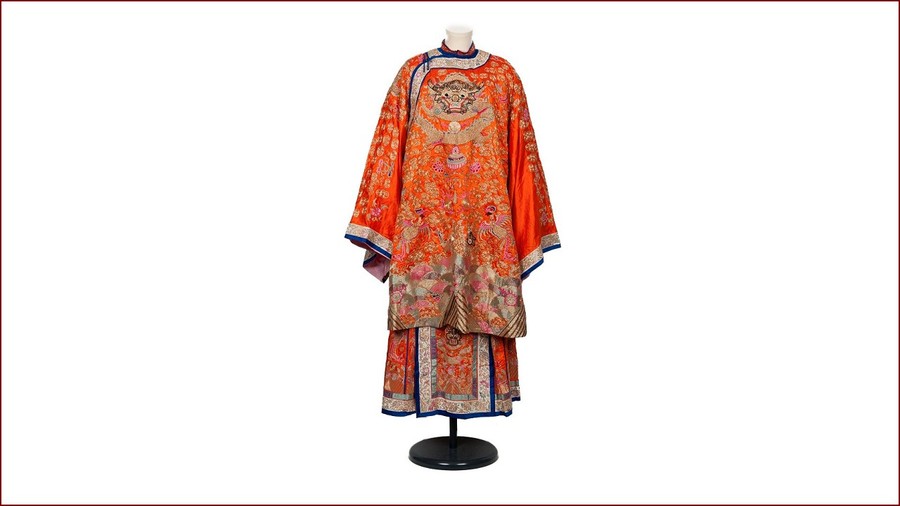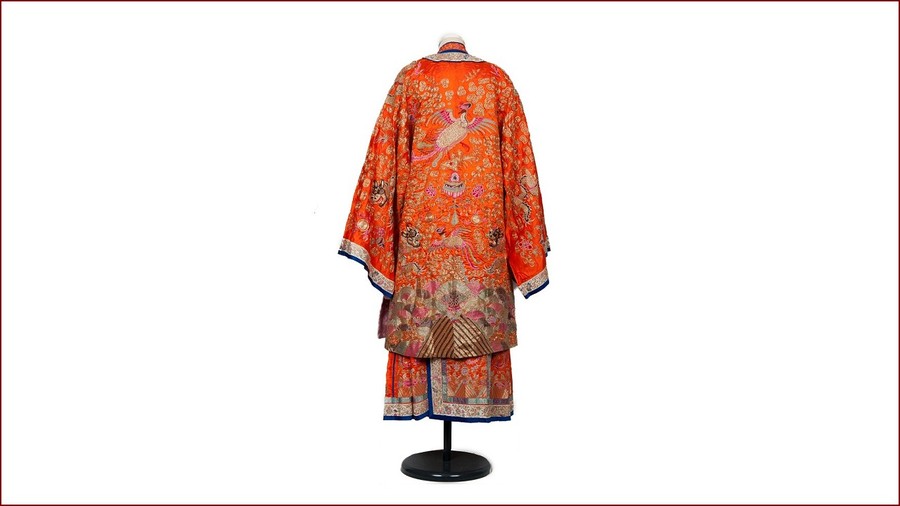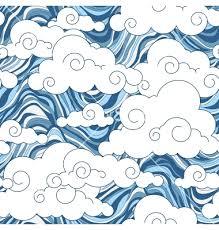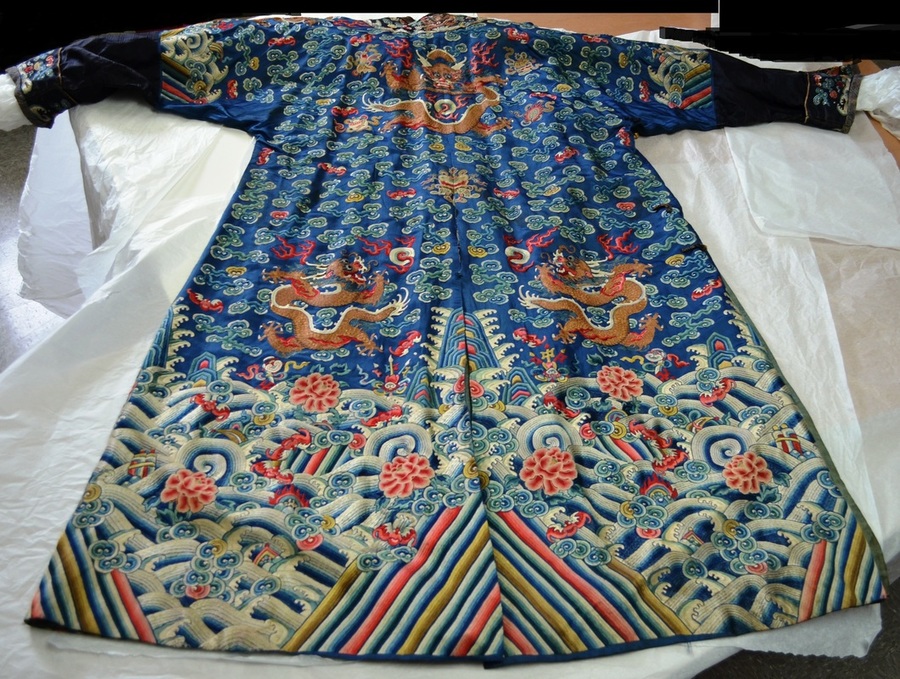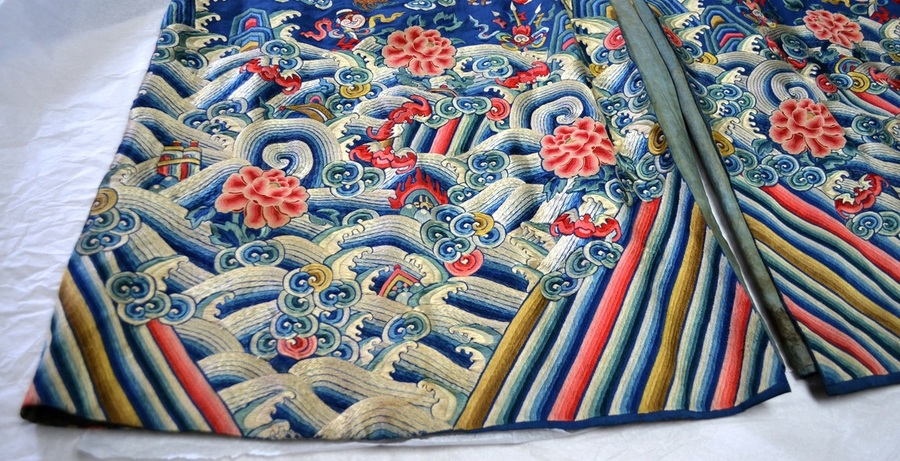Difference between revisions of "User:0863700"
| Line 38: | Line 38: | ||
Because of this mingle the traditional crafts of both lands merged together. Like Chinese embroidery with Indonesian batik. | Because of this mingle the traditional crafts of both lands merged together. Like Chinese embroidery with Indonesian batik. | ||
| − | Also all the pictures/ illustrations have a meaning and they value this a lot and they tell a sort of story. | + | Also all the pictures/ illustrations have a meaning and they value this a lot and they tell a sort of story. |
| Line 95: | Line 95: | ||
''The main symbols on the robe are dragons, appearing on the chest, torso, shoulders, and collar. In the Chinese tradition, dragons represent imperial authority, which is appropriate for a robe designed to be worn for government occasions.The dragons take the center on a background that represents the visible universe, including rocks, clouds and water that cover most of the robe. The prism-like design at the corners represents the earth, surrounded by the universal ocean, represented in the robe’s border. The wearer of the robe completes the cosmology symbolized in the designs. The wearer’s body represents the axis aligning earth and heaven, while the neck opening in the garment represents the gate of heaven, and the wearer’s head represents the realm of the spiritual.'' | ''The main symbols on the robe are dragons, appearing on the chest, torso, shoulders, and collar. In the Chinese tradition, dragons represent imperial authority, which is appropriate for a robe designed to be worn for government occasions.The dragons take the center on a background that represents the visible universe, including rocks, clouds and water that cover most of the robe. The prism-like design at the corners represents the earth, surrounded by the universal ocean, represented in the robe’s border. The wearer of the robe completes the cosmology symbolized in the designs. The wearer’s body represents the axis aligning earth and heaven, while the neck opening in the garment represents the gate of heaven, and the wearer’s head represents the realm of the spiritual.'' | ||
| + | |||
| + | |||
| + | '''COLOR''' | ||
| + | |||
| + | ''BLACK'' | ||
| + | |||
| + | Black, corresponding to water, is a neutral color. The I Ching, or Book of Changes, regards black as Heaven’s color. The saying “heaven and earth of mysterious black” was rooted in the observation that the northern sky was black for a long time. They believed Tian Di, or Heavenly Emperor, resided in the North Star. | ||
| + | The Taiji symbol uses black and white to represent the unity of Yin and Yang. Ancient Chinese regarded black as the king of colors and honored black more consistently than any other color. Lao Zi said that five colors make people blind, so the Dao School chose black as the color of the Dao. Black also means depression, sadness, and possibly means death. | ||
| + | In modern China, black is used in daily clothing. White is associated with death and mourning and was formerly worn at funerals, but depends on the age of passing. | ||
| + | |||
| + | ''RED'' | ||
| + | |||
| + | Red, corresponding with fire, symbolizes good fortune and joy. Red is found everywhere during Chinese New Year and other holidays and family gatherings. A red envelope is a monetary gift which is given in Chinese society during holiday or special occasions. The red color of the packet symbolizes good luck. Red is strictly forbidden at funerals as it is a traditionally symbolic color of happiness; however, as the names of the dead were previously written in red, it may be considered offensive to use red ink for Chinese names in contexts other than official seals. | ||
| + | In modern China, red remains a very popular color and is affiliated with and used by the Communist government. | ||
| + | |||
| + | ''BLUE'' | ||
| + | |||
| + | Although Chinese now has a separate word for "blue" (蓝), it traditionally grouped most shades of blue together with green under the name 青 (qing), whose character derives from the idea of sprouting plant life. This color corresponds to the Chinese element of wood (i.e., vegetative life), represents nature and renewal, and often indicates spring. The color implies vigor and vitality. | ||
| + | |||
| + | ''GREEN'' | ||
| + | |||
| + | Generally green is associated with health, prosperity, and harmony. Recently, the color has also been associated with the PRC's harmonization efforts, such as the controversial Green Dam Youth Escort internet censorship software. | ||
| + | Separately, green hats are associated with infidelity and used as an idiom for a cuckold. This has caused uneasiness for Chinese Catholic bishops, who in ecclesiastical heraldry would normally have a green hat above their arms. Chinese bishops have compromised by using a violet hat for their coat of arms. Sometimes this hat will have an indigo feather to further display their disdain for the color green. | ||
| + | |||
| + | ''WHITE'' | ||
| + | |||
| + | White, corresponding with metal, represents gold and symbolizes brightness, purity, and fulfillment. White is also the color of mourning. It is associated with death and is used predominantly in funerals in Chinese culture. Ancient Chinese people wore white clothes and hats only when they mourned for the dead. | ||
| + | |||
| + | ''YELLOW'' | ||
| + | |||
| + | Yellow, corresponding with earth, is considered the most beautiful and prestigious color. The Chinese saying, Yellow generates Yin and Yang, implies that yellow is the center of everything. Associated with but ranked above brown, yellow signifies neutrality and good luck. Yellow is sometimes paired with red in place of gold. | ||
| + | Yellow was the emperor's colour in Imperial China and is held as the symbolic color of the five legendary emperors of ancient China. Yellow often decorates royal palaces, altars and temples, and the color was used in the robes and attire of the emperors. | ||
| + | Yellow also represents freedom from worldly cares and is thus esteemed in Buddhism. Monks’ garments are yellow, as are elements of Buddhist temples. Yellow is also used as a mourning color for Chinese Buddhists. | ||
| + | Yellow is also symbolic of heroism, as opposed to the American association of the colour with cowardice. | ||
Revision as of 10:56, 22 September 2015
FANTASTIC FORGERIES
MY PICK
Peranakan , Jawa , Indonesië
date:
ca. 1900
measurements:
108 × 70 × 20 cm 170cm arm wideness
embroidery, silk
The orange jacket and skirt are put together to become a traditional wedding costume for the Peranakan Chinese.
Orange was a very beloved color for the Peranakan Chinese and the coat is called ‘mang ao’ , dragon coat.
This color orange was called ‘kuning pinang masak’ and referred to the yellow/orange color of the betel-palm.
The coat has different embroidered motives like a dragon, phoenix, peonies, clouds, mountains and waves.
The dragon and phoenix together stand for marriage luck. The clouds, mountains and waves represent air, land and water and with that the cosmos.
WHY
I picked this costume because I am interested in Asian culture and there history and crafts.
This costume fascinated me because I found out that in the time this costume is made there was a emigration stream of Chinese people coming to Indonesia.
Because of this mingle the traditional crafts of both lands merged together. Like Chinese embroidery with Indonesian batik.
Also all the pictures/ illustrations have a meaning and they value this a lot and they tell a sort of story.
This is something I like in a costume or garment, you can tell a story by this and in my own work I use a lot of prints.
I also wanted to link it with my Major Fashion design so I can discover new crafts and continue with my development in the major.
REPLICA
To make a replica of the wedding costume I want to do more research about the different illustations and meanings of these, discover more about the Chinese/Indonesian history and techniques used in this time.
After this desk research I want to start with material experiments to replicate the costume using modern day crafts or digital techniques and give the costume a new look.
RESEARCH
CHINESE JIFU
SYMBOLS IN SILK
In vibrant blues, greens, reds, and yellows, intricately embroidered motifs rich with symbolism cover this Chinese silk jifu from around 1900. It reflects a style introduced by the Manchu in the 1600s when they arrived in China, a style which continued to be influential throughout the Quing dynasty. The garment would have expressed the wearer’s Manchu ethnic background. The Manchu style includes elements that suggest the garment could be worn while riding a horse, such as the split front and the crescent shape at the ends of the sleeves, which protect the back of the hands. Of course, a fine robe such as this one would not actually have been worn for riding. A jifu is a semi-formal garment made to be worn at important government functions. The robe is made of a deep blue silk satin, and lined with a pale blue lightweight silk. T he decoration is hand-embroidered silk and some metallic thread used for the bodies of the dragons. The choice of embroidery rather than woven designs is one of the clues that it is from around the turn of the 20th century. Another elegant detail is the several metal buttons that close the front of the robe.
This jifu is decorated with a number of Buddhist symbols and others from Chinese culture. For example, the peonies symbolize prosperity, and the small red creatures are stylized depictions of bats, symbolizing happiness. The association between bats and happiness has its origins in a pun, as the words for “bat” and “happiness” are pronounced identically in Mandarin Chinese.
The main symbols on the robe are dragons, appearing on the chest, torso, shoulders, and collar. In the Chinese tradition, dragons represent imperial authority, which is appropriate for a robe designed to be worn for government occasions.The dragons take the center on a background that represents the visible universe, including rocks, clouds and water that cover most of the robe. The prism-like design at the corners represents the earth, surrounded by the universal ocean, represented in the robe’s border. The wearer of the robe completes the cosmology symbolized in the designs. The wearer’s body represents the axis aligning earth and heaven, while the neck opening in the garment represents the gate of heaven, and the wearer’s head represents the realm of the spiritual.
COLOR
BLACK
Black, corresponding to water, is a neutral color. The I Ching, or Book of Changes, regards black as Heaven’s color. The saying “heaven and earth of mysterious black” was rooted in the observation that the northern sky was black for a long time. They believed Tian Di, or Heavenly Emperor, resided in the North Star. The Taiji symbol uses black and white to represent the unity of Yin and Yang. Ancient Chinese regarded black as the king of colors and honored black more consistently than any other color. Lao Zi said that five colors make people blind, so the Dao School chose black as the color of the Dao. Black also means depression, sadness, and possibly means death. In modern China, black is used in daily clothing. White is associated with death and mourning and was formerly worn at funerals, but depends on the age of passing.
RED
Red, corresponding with fire, symbolizes good fortune and joy. Red is found everywhere during Chinese New Year and other holidays and family gatherings. A red envelope is a monetary gift which is given in Chinese society during holiday or special occasions. The red color of the packet symbolizes good luck. Red is strictly forbidden at funerals as it is a traditionally symbolic color of happiness; however, as the names of the dead were previously written in red, it may be considered offensive to use red ink for Chinese names in contexts other than official seals. In modern China, red remains a very popular color and is affiliated with and used by the Communist government.
BLUE
Although Chinese now has a separate word for "blue" (蓝), it traditionally grouped most shades of blue together with green under the name 青 (qing), whose character derives from the idea of sprouting plant life. This color corresponds to the Chinese element of wood (i.e., vegetative life), represents nature and renewal, and often indicates spring. The color implies vigor and vitality.
GREEN
Generally green is associated with health, prosperity, and harmony. Recently, the color has also been associated with the PRC's harmonization efforts, such as the controversial Green Dam Youth Escort internet censorship software. Separately, green hats are associated with infidelity and used as an idiom for a cuckold. This has caused uneasiness for Chinese Catholic bishops, who in ecclesiastical heraldry would normally have a green hat above their arms. Chinese bishops have compromised by using a violet hat for their coat of arms. Sometimes this hat will have an indigo feather to further display their disdain for the color green.
WHITE
White, corresponding with metal, represents gold and symbolizes brightness, purity, and fulfillment. White is also the color of mourning. It is associated with death and is used predominantly in funerals in Chinese culture. Ancient Chinese people wore white clothes and hats only when they mourned for the dead.
YELLOW
Yellow, corresponding with earth, is considered the most beautiful and prestigious color. The Chinese saying, Yellow generates Yin and Yang, implies that yellow is the center of everything. Associated with but ranked above brown, yellow signifies neutrality and good luck. Yellow is sometimes paired with red in place of gold. Yellow was the emperor's colour in Imperial China and is held as the symbolic color of the five legendary emperors of ancient China. Yellow often decorates royal palaces, altars and temples, and the color was used in the robes and attire of the emperors. Yellow also represents freedom from worldly cares and is thus esteemed in Buddhism. Monks’ garments are yellow, as are elements of Buddhist temples. Yellow is also used as a mourning color for Chinese Buddhists. Yellow is also symbolic of heroism, as opposed to the American association of the colour with cowardice.
